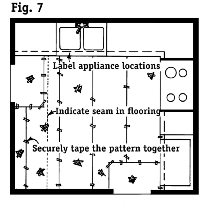
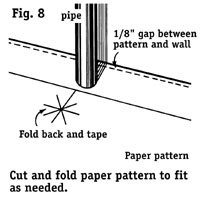
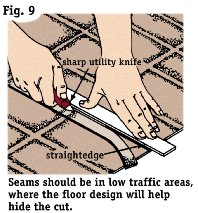
|
 MAKING
A PAPER PATTERN MAKING
A PAPER PATTERN
- Perhaps the easiest way to lay sheet vinyl is by using a paper pattern of the floor.
Installation kits are available that contain paper, guides and instructions. You can make
a pattern with brown kraft paper, a pair of scissors, straightedge, utility knife and some
masking tape.
- Begin by laying the paper down along the longest wall with the fewest obstructions. If
you cut your flooring the exact size of the room, it is likely to roll up or buckle. Allow
about an eight of an inch between the pattern and the wall (Fig. 7).
- Keep adding paper until you reach the opposite wall. Use masking tape to tape the paper
together. Cut small diamond shapes about every two to four feet in all directions on your
pattern. Place masking tape over these cutouts to hold the pattern in place.
- Keep the paper as smooth as possible. Use plenty of tape along the edges of the paper to
hold the pattern together. Use small sheets of paper to fit around pipes, toilets,
cabinets, appliances and heating vents. Cut and fold these smaller pieces to fit. Then
tape them to the pattern (Fig. 8). If you make an opening too large, use tape and paper to
correct the size.
- After you have completed the pattern, use a felt marker to mark the side of the pattern.
- Carefully roll or fold the pattern. Take it to a large clean floor area. A garage floor
that has been thoroughly swept works well.
- Most sheet flooring today is sold in 12 foot widths. If you have a room that is larger
than 12 feet in length and width, you will need to make a seam. Plan for seams to be in
low traffic areas if possible. Use the pattern of your flooring to help hide the seam. For
example, if your pattern has heavy lines, such as sides of boards or grout lines, make
your seam along these lines.
- To make the seam, lay the larger piece of flooring down first, right side up. Then place
the smaller piece, right side up also, so the two pieces overlap by at least an inch. Most
importantly, lay them so the pattern on both pieces match (Fig. 9). Tape the two pieces
together.
- Use a straightedge and sharp utility knife to cut through both layers of flooring.
Depending on where you are working, you may want to lay pieces of cardboard under the
flooring so you don't damage the floor. Remove the two trimmed edges. Carefully put the
seam together again and retape the seam.
- After the seam is made, you are ready to cut the flooring. Place the pattern, right side
up, on top of the flooring. If you haven't already done so, remove the tape covering the
small diamonds and replace it with new tape. Be sure the pattern is laying so that the
seam is where you planned and that it is laying flat.
- To cut the flooring you have two options. You can trace the pattern onto the flooring
using a straightedge and a marker. And then cut it with heavy shears or snips. Or you can
use a utility knife and straightedge and cut around the pattern. Either way, be very
careful.
- After you have finished cutting the flooring, carefully roll it. The way you roll it can
make the job easier. For example, rolling it toward an edge that goes next to a cabinet
makes fitting it under the toe plate easier. Also, remember the length. If you have to go
around any sharp corners, roll it so it is as short as possible.
|




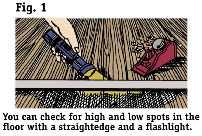


 MAKING
A PAPER PATTERN
MAKING
A PAPER PATTERN 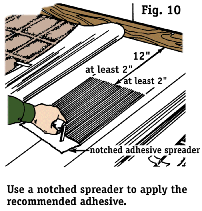
 LAYING ROLL GOODS
LAYING ROLL GOODS
